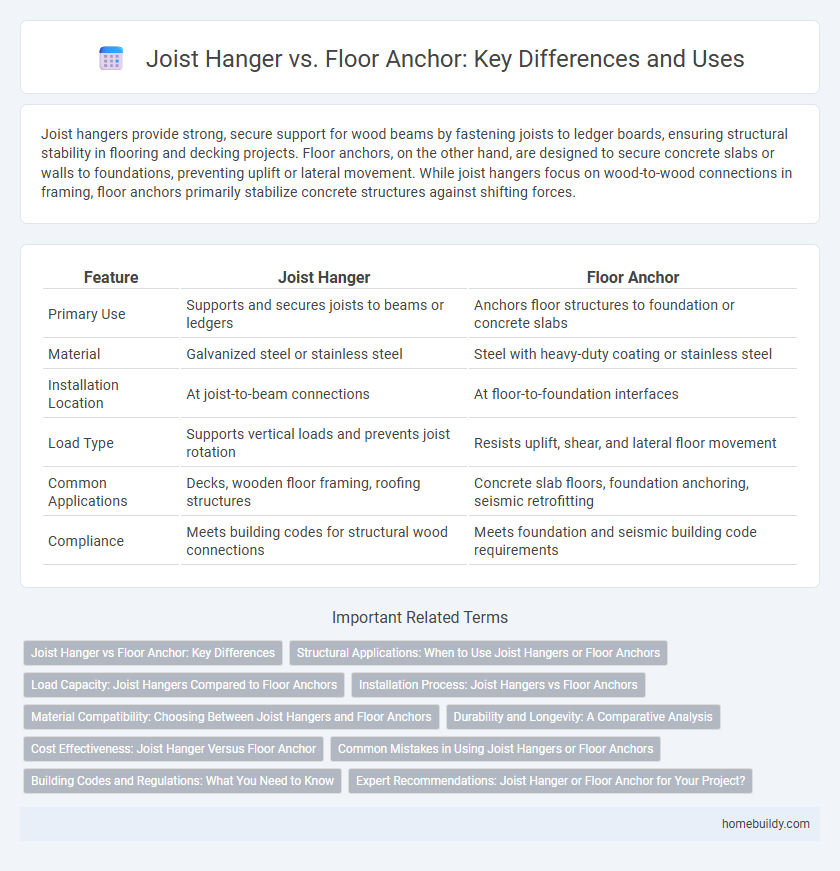Joist hangers provide strong, secure support for wood beams by fastening joists to ledger boards, ensuring structural stability in flooring and decking projects. Floor anchors, on the other hand, are designed to secure concrete slabs or walls to foundations, preventing uplift or lateral movement. While joist hangers focus on wood-to-wood connections in framing, floor anchors primarily stabilize concrete structures against shifting forces.
Table of Comparison
| Feature | Joist Hanger | Floor Anchor |
|---|---|---|
| Primary Use | Supports and secures joists to beams or ledgers | Anchors floor structures to foundation or concrete slabs |
| Material | Galvanized steel or stainless steel | Steel with heavy-duty coating or stainless steel |
| Installation Location | At joist-to-beam connections | At floor-to-foundation interfaces |
| Load Type | Supports vertical loads and prevents joist rotation | Resists uplift, shear, and lateral floor movement |
| Common Applications | Decks, wooden floor framing, roofing structures | Concrete slab floors, foundation anchoring, seismic retrofitting |
| Compliance | Meets building codes for structural wood connections | Meets foundation and seismic building code requirements |
Joist Hanger vs Floor Anchor: Key Differences
Joist hangers are metal brackets designed to provide strong support by securely fastening wooden joists to beams, ensuring structural stability in framing projects. Floor anchors, on the other hand, are devices used to stabilize and secure flooring systems to a foundation or subfloor, primarily preventing lateral movement. The key difference lies in their application and function: joist hangers focus on joist-to-beam connections for load-bearing support, while floor anchors aim to anchor flooring systems to maintain alignment and prevent shifting.
Structural Applications: When to Use Joist Hangers or Floor Anchors
Joist hangers provide critical support by securely fastening joists to beams, ideal for elevated floor framing where load distribution and stability are essential. Floor anchors are best utilized for securing floor slabs to foundation walls, preventing lateral movement and uplift in slab-on-grade constructions. Choosing between joist hangers and floor anchors depends on whether the structural application requires overhead load support or slab-to-foundation anchorage.
Load Capacity: Joist Hangers Compared to Floor Anchors
Joist hangers provide superior load capacity by distributing weight evenly across the supporting structure, typically handling loads up to 1,000 pounds or more depending on the model and installation. Floor anchors primarily stabilize vertical movement and generally offer lower load-bearing capacity, often supporting less than 500 pounds when compared directly. Engineers select joist hangers over floor anchors in applications requiring enhanced structural support and heavy load distribution across beams and joists.
Installation Process: Joist Hangers vs Floor Anchors
Joist hanger installation involves attaching metal brackets directly to framing members using nails or screws, providing strong support for joists by securing them at precise angles. Floor anchors require drilling into concrete or masonry floors and embedding the anchor with epoxy or mechanical fasteners, which demands more specialized tools and preparation. Compared to floor anchors, joist hangers offer quicker installation on wooden frameworks, while floor anchors provide superior stability for slab-on-grade or basement flooring systems.
Material Compatibility: Choosing Between Joist Hangers and Floor Anchors
Joist hangers are typically made from galvanized steel, providing strong corrosion resistance and compatibility with wood framing materials, ensuring secure connections in wooden structures. Floor anchors often consist of heavy-duty steel with protective coatings designed for concrete and masonry surfaces, making them ideal for securing floor assemblies to foundations. Selecting between joist hangers and floor anchors hinges on the substrate material, where joist hangers excel with wood and floor anchors provide stability in concrete-based flooring systems.
Durability and Longevity: A Comparative Analysis
Joist hangers, typically made from galvanized steel, offer superior durability and corrosion resistance compared to floor anchors, which often use less robust materials. The zinc coating on joist hangers protects against rust and weathering, extending their lifespan in outdoor and high-moisture environments. Floor anchors may degrade faster under similar conditions, making joist hangers a preferred choice for long-term structural support in decking and flooring projects.
Cost Effectiveness: Joist Hanger Versus Floor Anchor
Joist hangers typically offer greater cost effectiveness compared to floor anchors by simplifying installation and reducing labor time. The materials for joist hangers are generally less expensive, while their design provides reliable load distribution, minimizing the need for additional reinforcement. Floor anchors often involve more complex groundwork and higher material costs, making joist hangers a budget-friendly choice for deck and floor framing projects.
Common Mistakes in Using Joist Hangers or Floor Anchors
Common mistakes in using joist hangers or floor anchors include improper sizing that fails to support the structural load, leading to compromised stability. Incorrect nail placement or using nails instead of manufacturer-recommended screws can reduce the holding strength and risk joint failure. Overlooking local building codes and installation guidelines often results in inadequate fastening, increasing the likelihood of safety hazards.
Building Codes and Regulations: What You Need to Know
Joist hangers and floor anchors are both critical for structural integrity, but building codes often specify distinct requirements for each based on load capacity and installation methods. Joist hangers must comply with local building regulations that dictate material standards, fastening techniques, and spacing to ensure durability and safety. Understanding the specific code mandates for joist hangers versus floor anchors helps contractors avoid violations and guarantees compliance during inspections.
Expert Recommendations: Joist Hanger or Floor Anchor for Your Project?
Experts recommend joist hangers for projects requiring strong lateral support and load distribution across beams, particularly in deck and floor framing. Floor anchors are preferred for securing structures directly to concrete slabs, providing stability against uplift forces and preventing movement. Choosing between a joist hanger and a floor anchor depends on the structural requirements, material compatibility, and specific load conditions of your project.
joist hanger vs floor anchor Infographic

 homebuildy.com
homebuildy.com